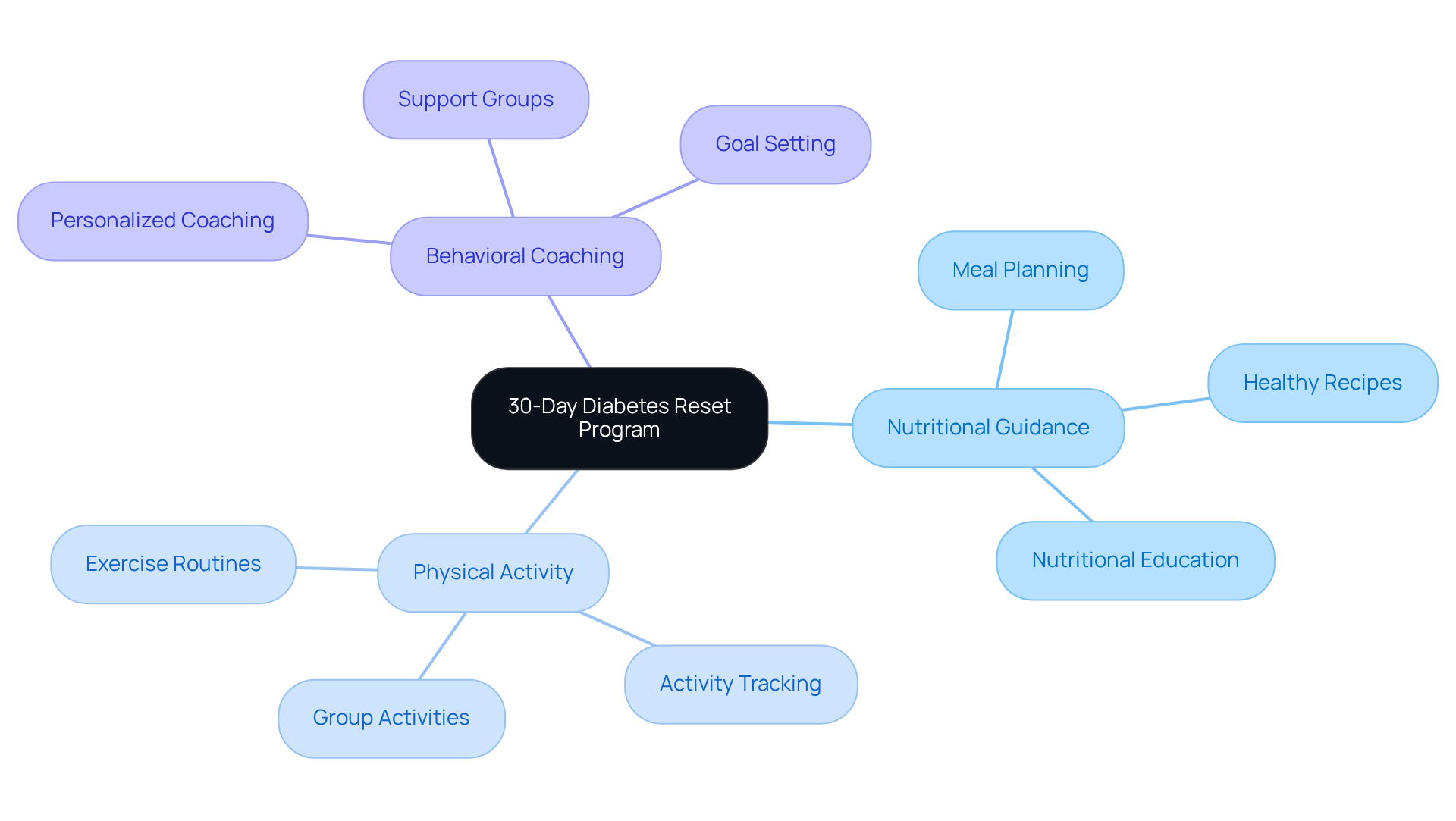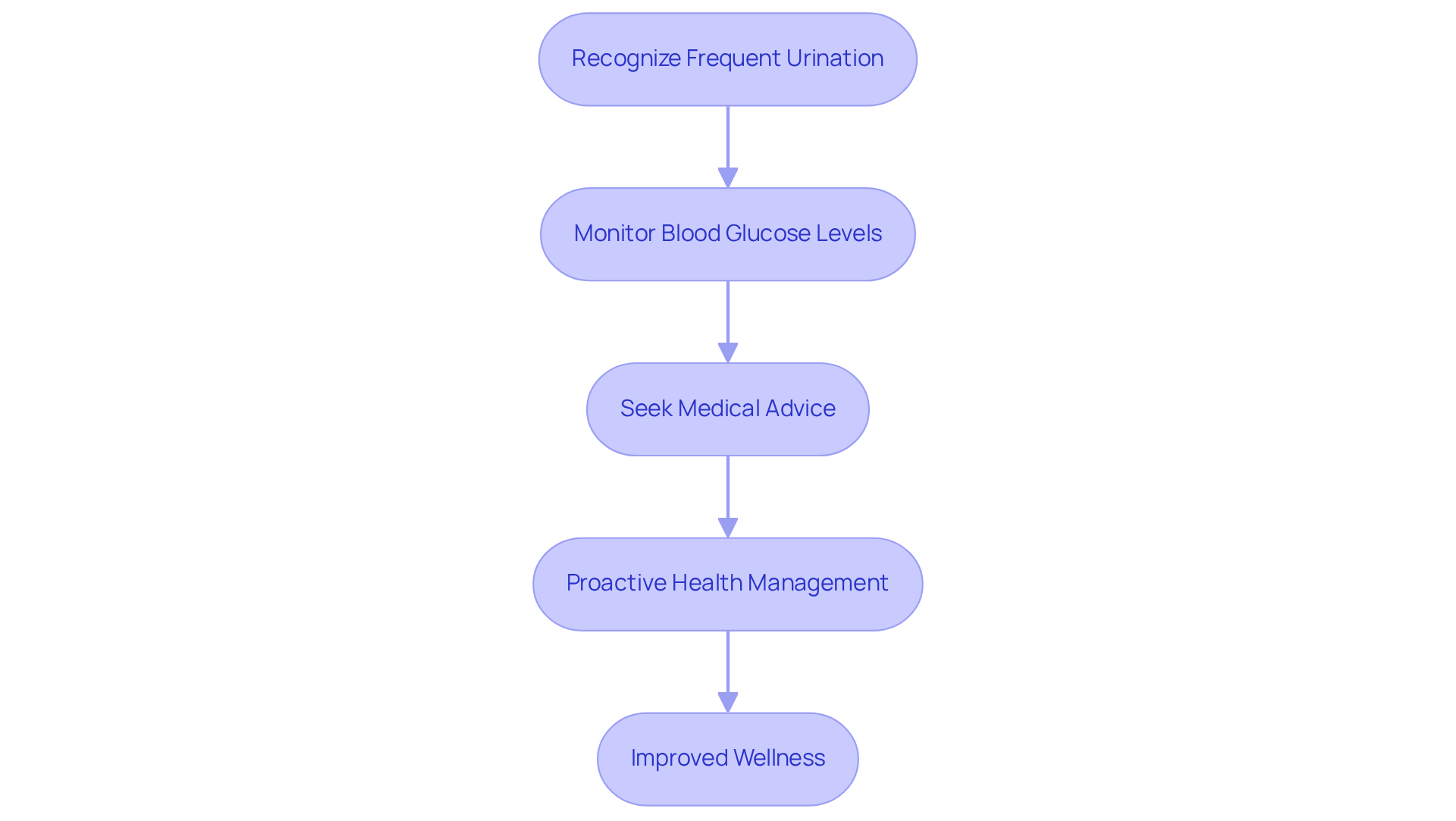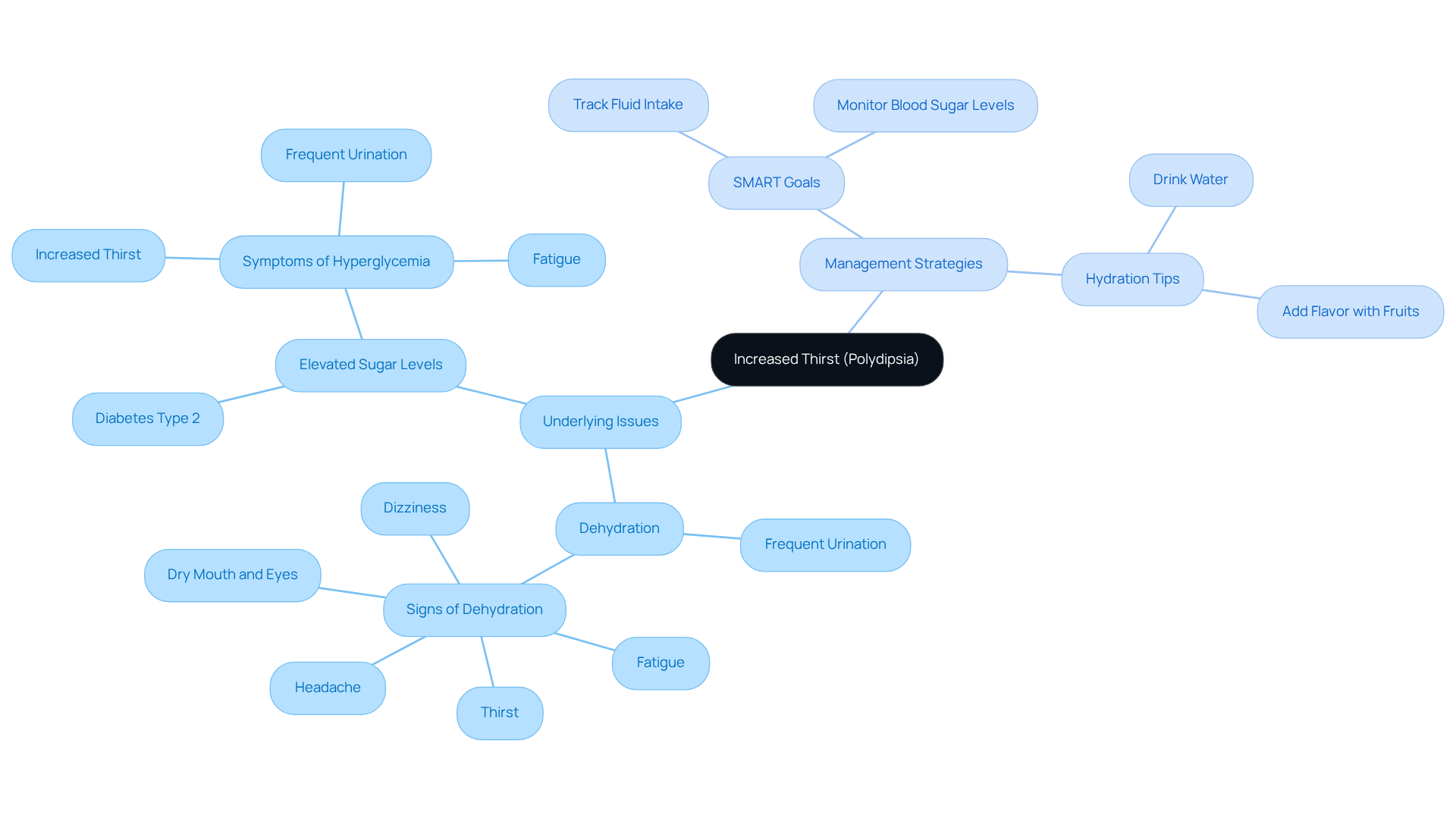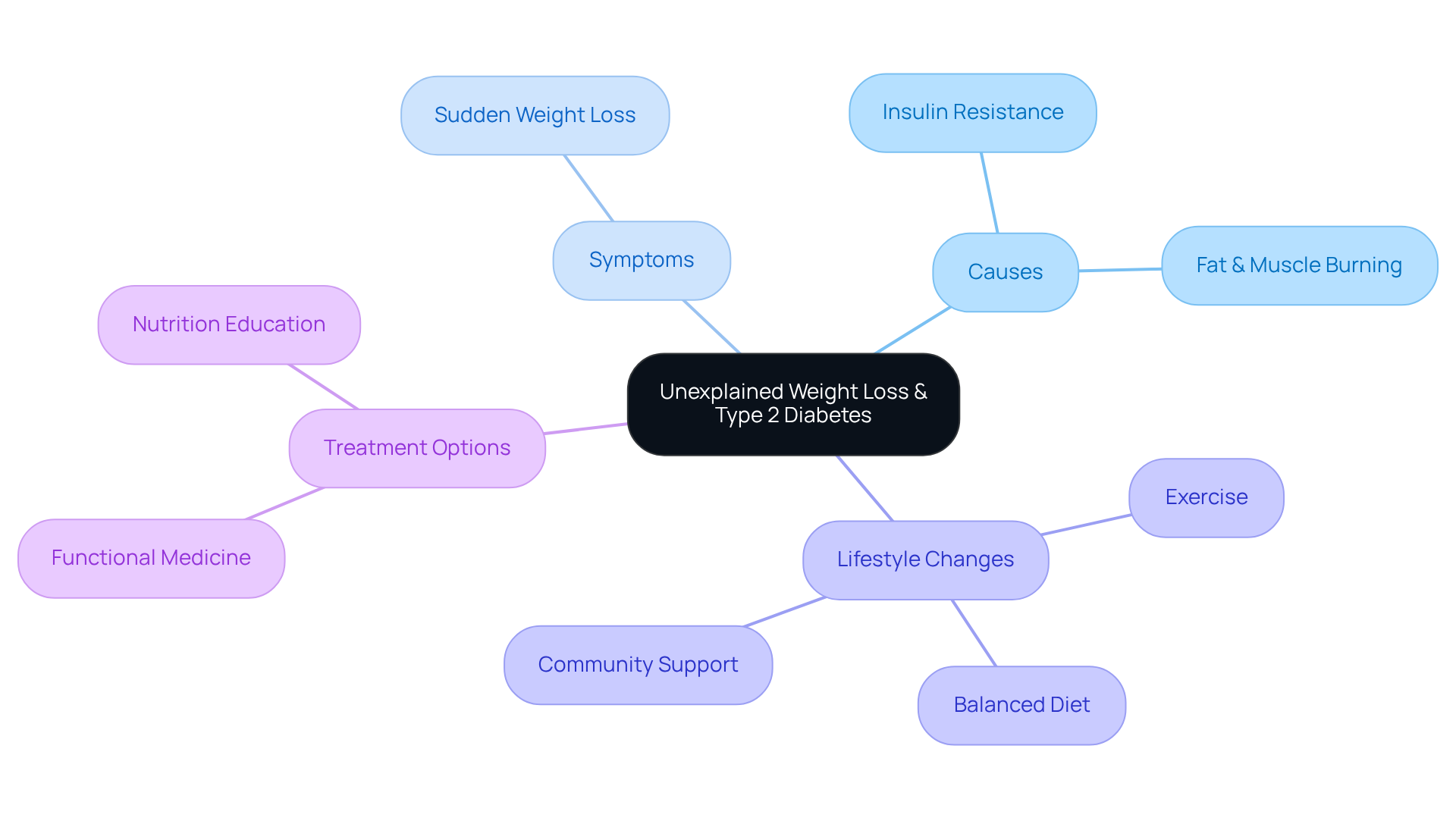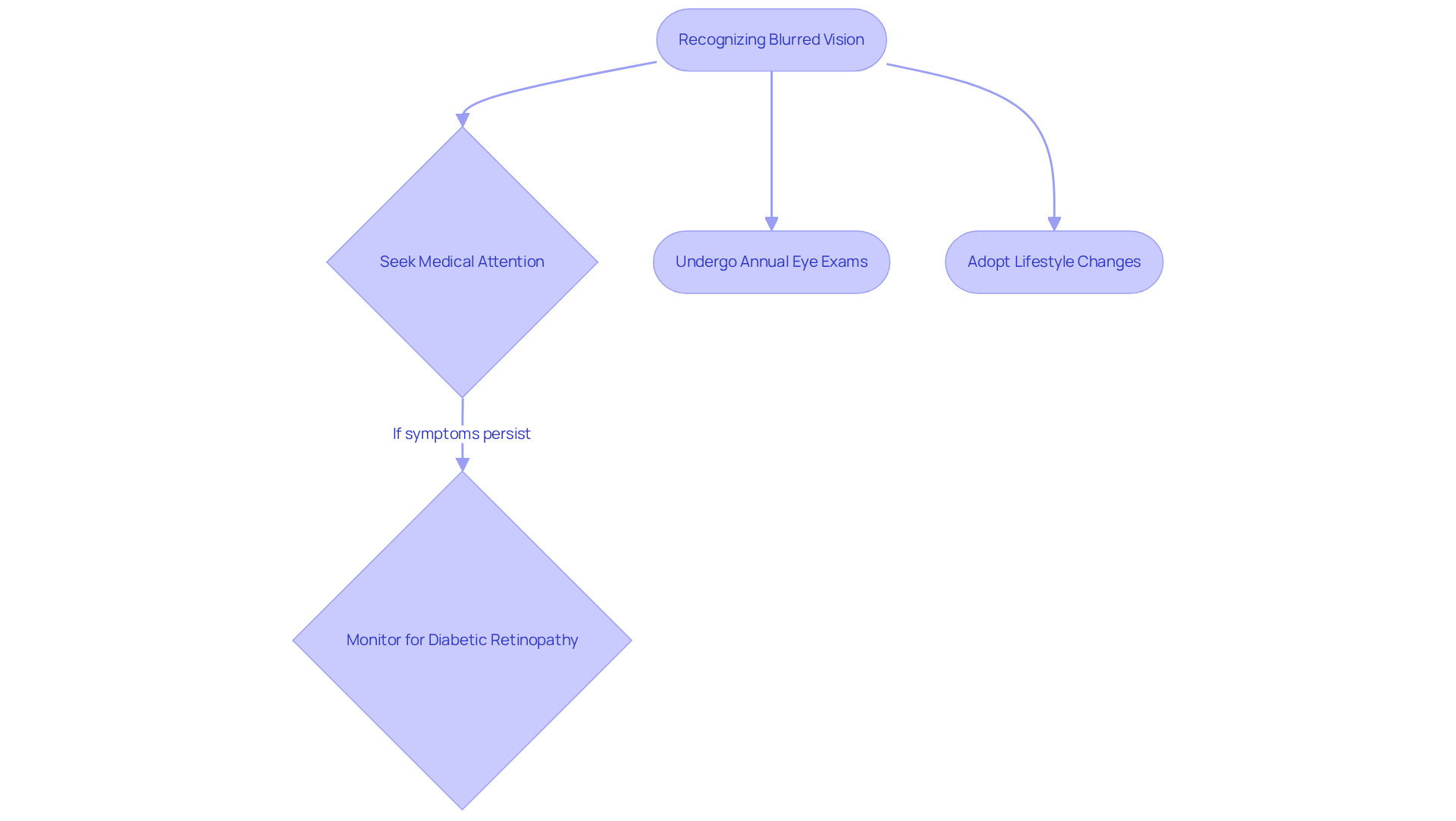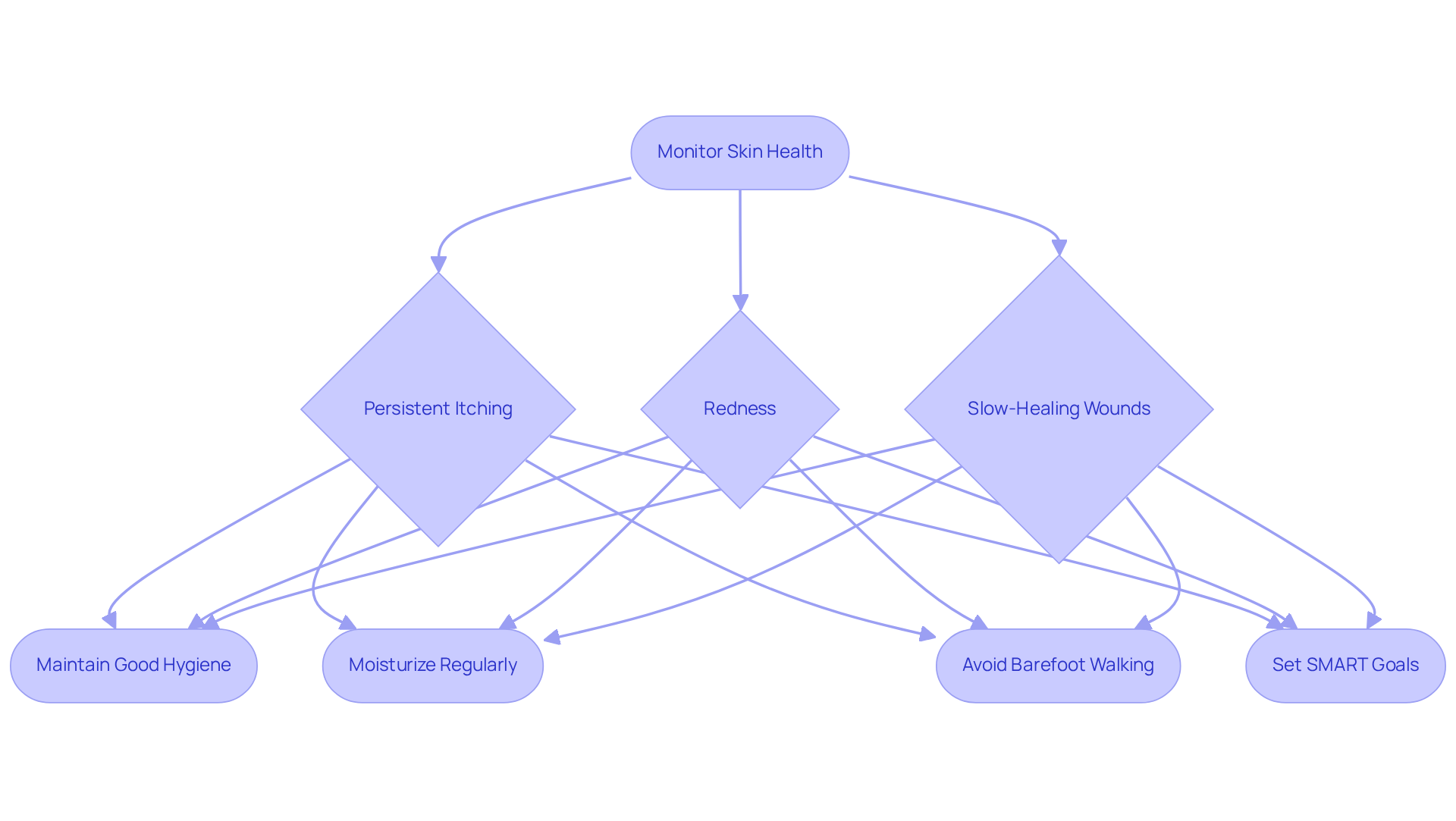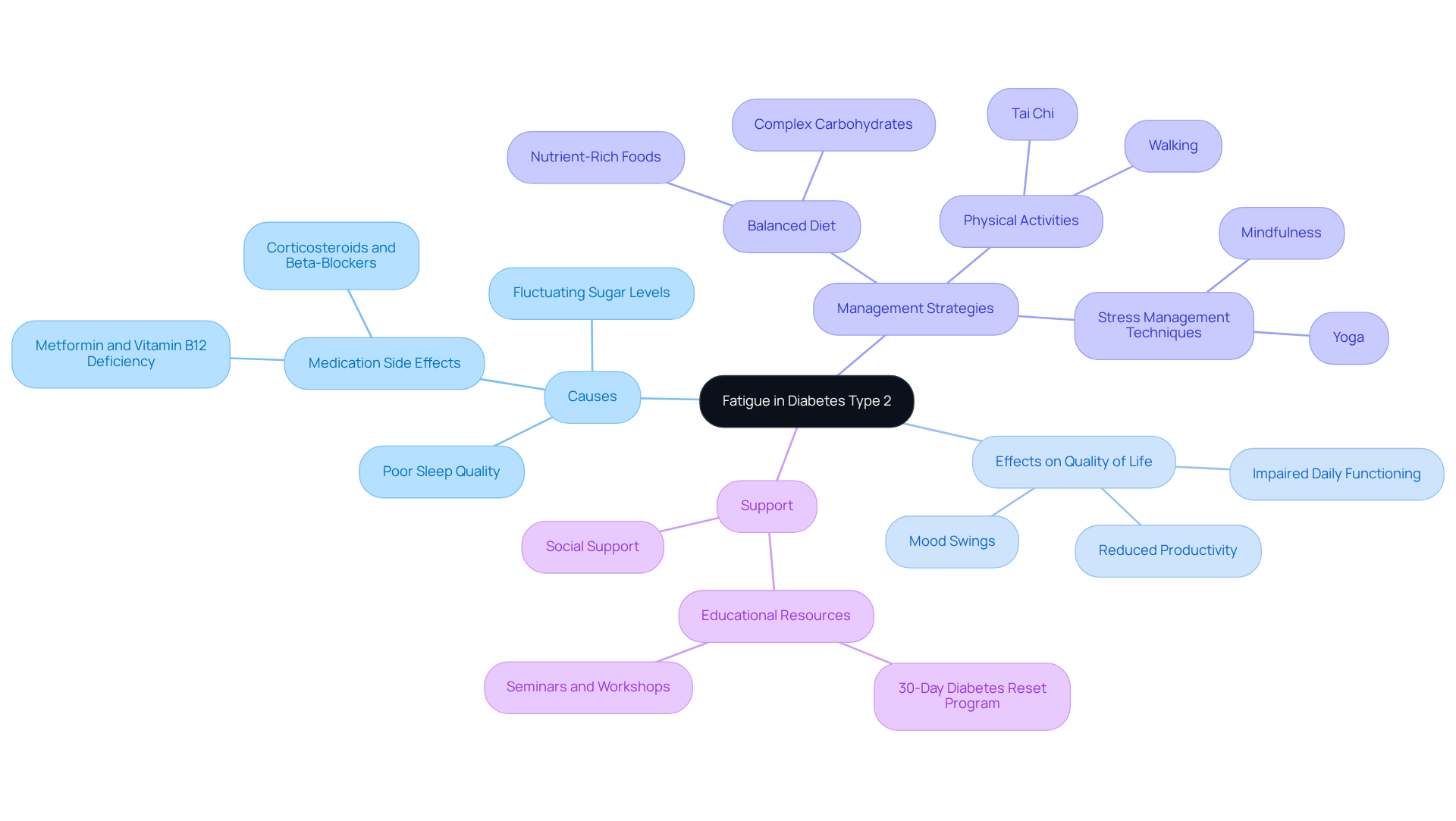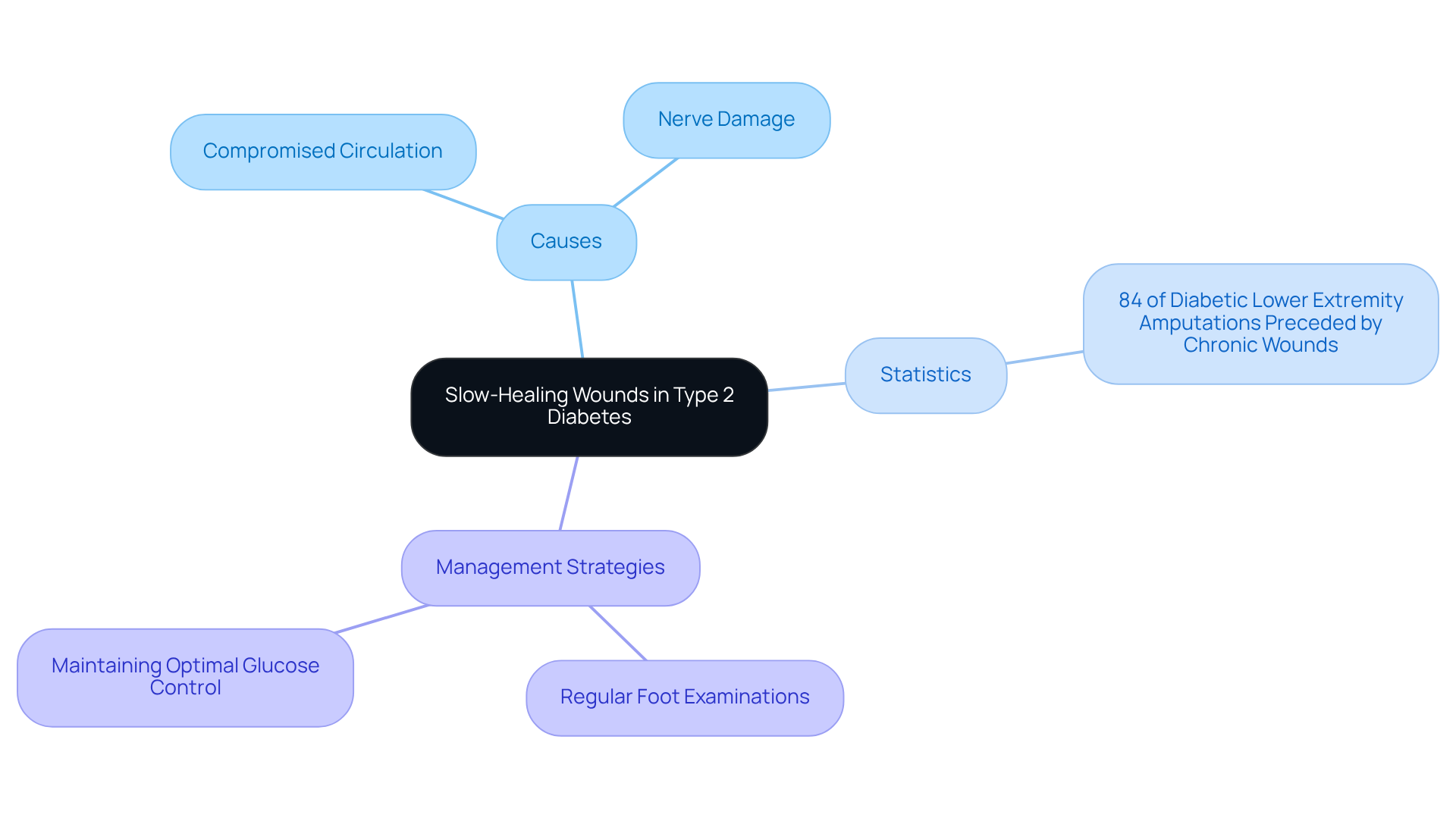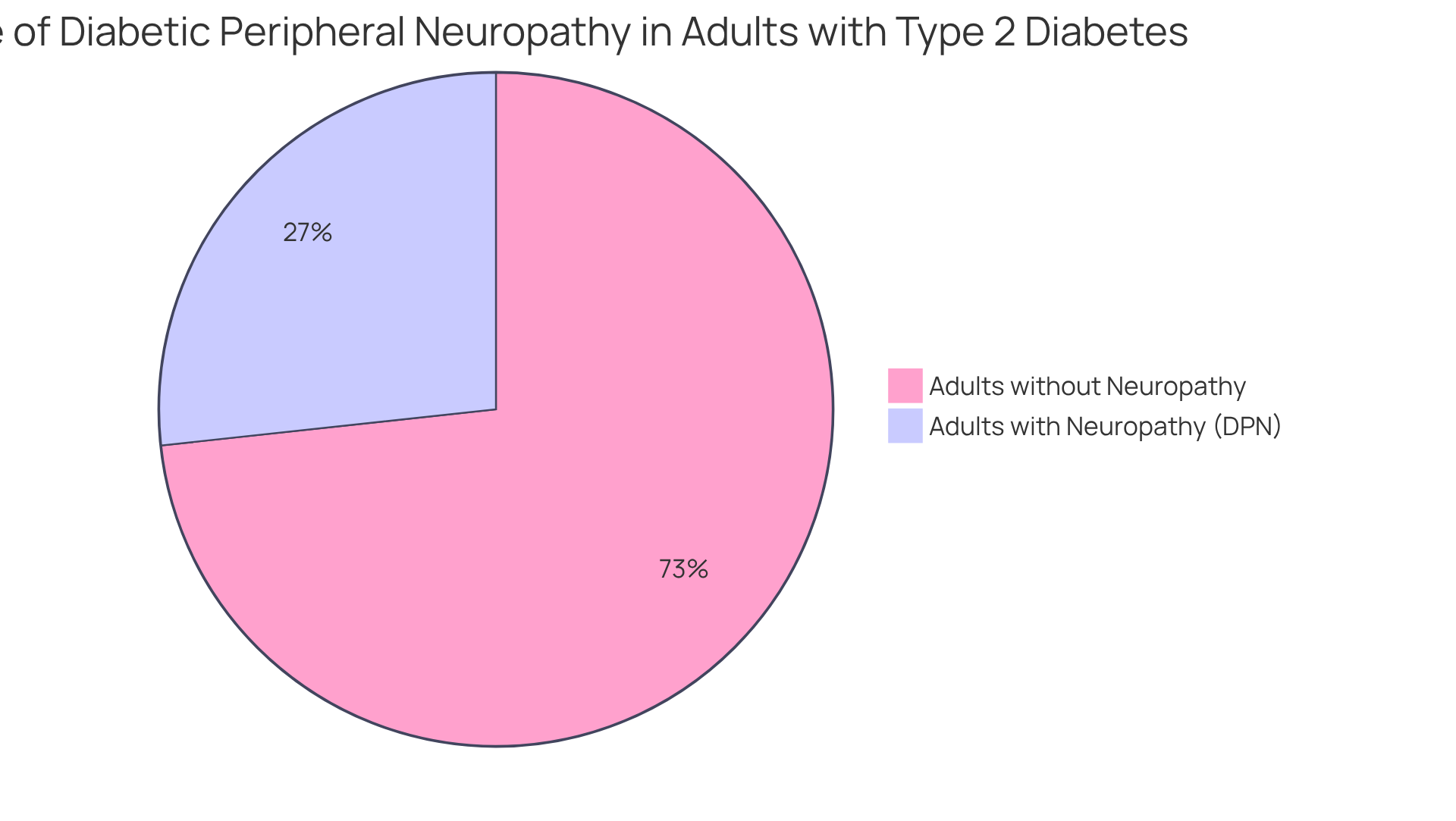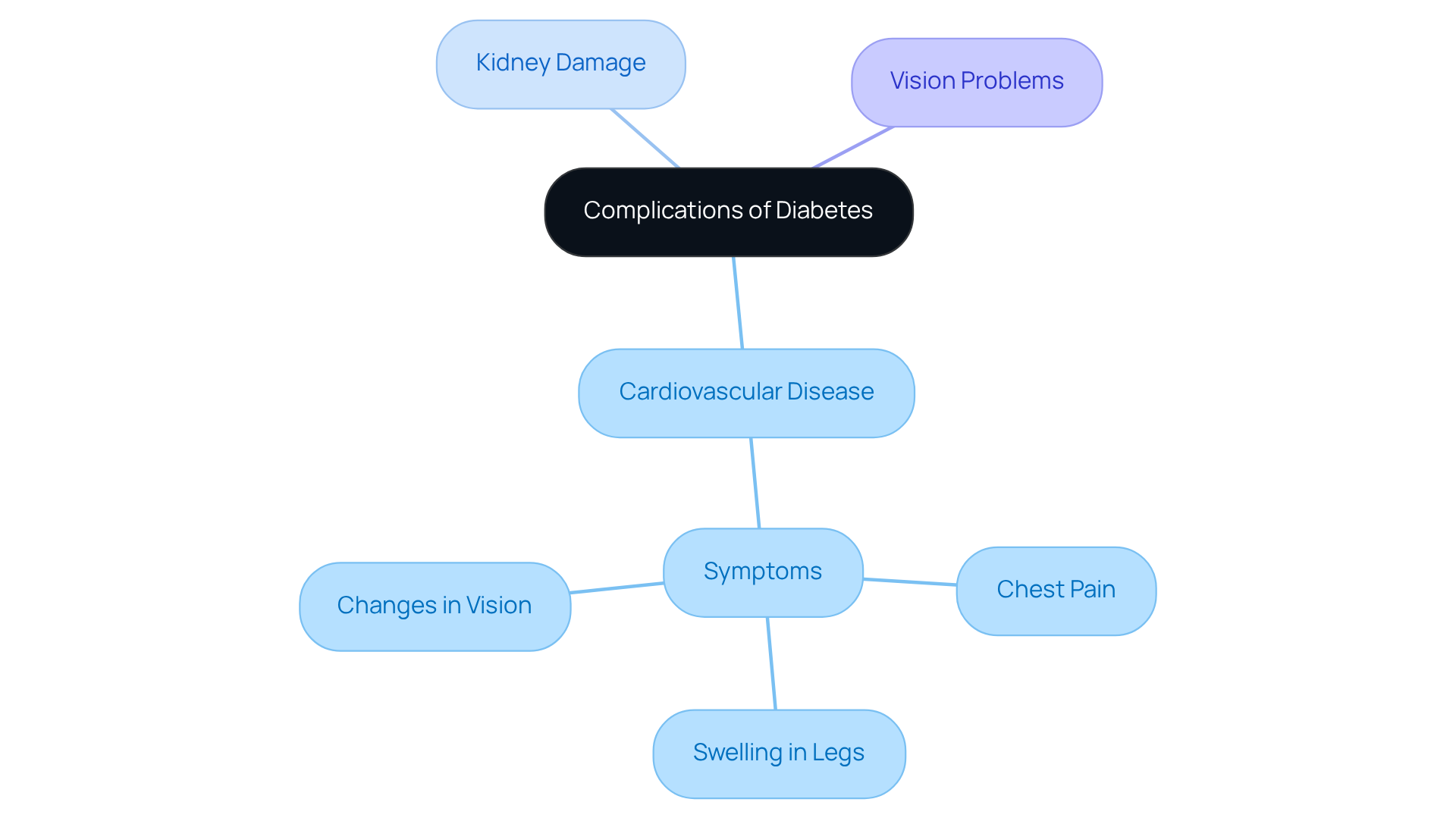Overview
This article sheds light on the key symptoms of type 2 diabetes in adults that deserve our attention. It’s crucial to recognize these signs early, as they can significantly affect your health and well-being. Symptoms such as:
- Frequent urination
- Increased thirst
- Unexplained weight loss
- Blurred vision
- Fatigue
are not just mere inconveniences; they are important indicators that can signal the need for prompt medical attention.
Many individuals find themselves grappling with these symptoms, often feeling overwhelmed and uncertain about what they mean. It’s important to acknowledge that experiencing these signs can be distressing. However, understanding them is the first step toward effective diabetes management. By recognizing these symptoms, you can take proactive steps to seek help and improve your health.
Remember, addressing these symptoms early can lead to better outcomes. If you or someone you know is experiencing any of these indicators, consider reaching out to a healthcare professional. You deserve support and guidance on your journey toward a healthier life.
Introduction
Recognizing the signs of type 2 diabetes is crucial for early intervention and effective management. As the prevalence of this condition continues to rise, understanding its symptoms can empower you to take proactive steps toward better health. In this article, we’ll explore ten critical symptoms that adults should never overlook. These indicators can signal underlying issues, and it’s important to seek timely medical advice.
Have you ever considered what might happen if you ignore these signs? Reflecting on this question can highlight the urgency of awareness and action in your journey of managing diabetes.
Integrative Wellness Center: Dr. Jason Shumard’s 30-Day Diabetes Reset Program
Are you feeling overwhelmed by your diabetes diagnosis? Dr. Jason Shumard’s groundbreaking and clinically validated 30-Day Diabetes Reset Program offers a revolutionary holistic approach that empowers you to take control of your condition. This program thoughtfully integrates nutritional guidance, physical activity, and behavioral coaching, focusing on the root causes of diabetes rather than merely addressing symptoms.
It’s important to recognize that managing diabetes can be challenging. By providing you with essential tools and knowledge, the program promotes long-term wellness improvements, including stabilizing glucose levels without reliance on insulin and prescription medications. Many participants find that personalized coaching enhances their experience, allowing them to receive tailored support that meets their unique needs.
Furthermore, educational resources, including Dr. Shumard’s books and seminars, along with a supportive community environment, encourage sustainable lifestyle changes. These elements significantly impact your overall health and well-being. With almost 20 years of expertise in functional medicine, Dr. Jason Shumard, D.C., has assisted thousands of patients in naturally reversing type II metabolic disorder.
Research indicates that comprehensive metabolic reset programs can lead to substantial improvements in glycemic control and quality of life. In fact, many participants report life-changing outcomes. This highlights the effectiveness of functional medicine in managing blood sugar issues, distinguishing Dr. Shumard’s program from traditional treatments that often depend on elevated insulin levels.
Are you ready to embark on a journey toward better health? With the right support and guidance, you can make meaningful changes that enhance your life.
Frequent Urination: A Key Indicator of Type 2 Diabetes
Frequent urination, known as polyuria, can be a significant indicator of type 2 metabolic disorder. This condition occurs when the kidneys filter excess glucose from the bloodstream, leading to increased urine production. Have you noticed needing to urinate more often than usual, especially at night? This can disrupt your sleep and daily activities, making it vital to identify polyuria early. Recognizing this symptom can encourage you to seek medical guidance, potentially leading to a prompt diagnosis and better management of your health.
Many patients share that their awareness of frequent urination was a turning point in their wellness journey. It prompted them to monitor their blood glucose levels and reach out to healthcare professionals for support. This proactive approach can significantly impact blood sugar management and overall wellness.
The occurrence of this condition is on the rise, with projections suggesting that by 2030, around 50-55 million Americans will be living with it. Frequent urination often serves as one of the earliest symptoms of diabetes type 2 in adults related to glucose metabolism issues. It’s important to track your fluid intake and urinary patterns. By doing this, you can gain valuable insights into your wellness status and take necessary actions to address potential symptoms of diabetes type 2 in adults. Remember, you are not alone on this journey, and seeking help is a courageous step toward better health.
Increased Thirst: Recognizing a Common Diabetes Symptom
Increased thirst, known as polydipsia, can be a frustrating experience, often stemming from dehydration due to frequent urination. When your body loses more fluids than usual, it sends a signal to your brain to increase thirst. This can lead to excessive fluid consumption, which may not alleviate your thirst if the underlying issue—elevated sugar levels—is not addressed. If you’re dealing with persistent thirst, it’s important to seek advice from a medical professional who can assess your glucose levels and overall well-being.
To effectively manage this symptom and enhance your overall health, consider setting personalized wellness goals using the SMART framework—specific, measurable, attainable, relevant, and time-bound. For instance:
- Tracking your daily fluid intake
- Establishing a routine for monitoring your blood sugar levels
These actions can empower you to take control of your health. Many patients find that consistently assessing these objectives not only fosters a sense of responsibility but also allows for adjustments based on changing health circumstances, ultimately improving well-being concerning the symptoms of diabetes type 2 in adults. Remember, taking these steps can be a significant part of your journey toward better health.
Unexplained Weight Loss: A Warning Sign of Type 2 Diabetes
Unexplained weight loss can be a significant warning sign of type 2 diabetes, often occurring when the body resorts to burning fat and muscle for energy due to insufficient insulin or insulin resistance. This process may lead to noticeable weight loss, even when dietary intake remains unchanged. Many patients share their experiences of sudden weight loss as a result of their diabetes, highlighting how the condition impacts metabolism and energy utilization.
It’s important to recognize that recent research underscores the relationship between insulin resistance and weight loss. Increased insulin levels can signal the body to store fat instead of using it for energy, creating a paradox that leaves individuals feeling fatigued and hungry. This can be frustrating, as their bodies struggle to convert glucose into usable energy. Nutritionists emphasize that controlling insulin levels through dietary and lifestyle adjustments is essential for preventing additional weight loss and enhancing overall well-being.
Current data indicates that approximately 90% of individuals with diabetes exhibit symptoms of diabetes type 2 in adults, including unexplained weight loss. If you notice sudden weight loss without any intentional changes to your diet or exercise routine, it is crucial to seek medical advice. This could suggest unmanaged blood sugar issues or other significant health conditions that require immediate attention.
In San Marcos, CA, managing type 2 diabetes effectively involves embracing a holistic lifestyle. Consider incorporating:
- Regular exercise
- A balanced diet rich in local produce such as avocados and berries
- Community support
Participating in outdoor activities, like hiking at Lake San Marcos or strolling the paths at Discovery Lake, can improve insulin sensitivity and assist in stabilizing sugar levels. Additionally, incorporating seasonal fruits and vegetables from local farmers’ markets into your meals can provide essential nutrients and fiber, vital for regulating blood sugar.
Furthermore, engaging in community wellness initiatives can provide essential assistance and resources for managing blood sugar conditions. Many patients find that these programs focus on nutrition education and stress management techniques, such as yoga and meditation, which are crucial for overall well-being. By adopting these lifestyle changes, individuals can not only address unexplained weight loss but also improve their overall health outcomes and quality of life.
It’s also important to be aware of the risks associated with traditional treatments for blood sugar management, which may not address the underlying issues of insulin resistance. If you’re looking for tailored advice, consider reaching out to Dr. Jason Shumard, who focuses on functional medicine strategies for successful blood sugar control. Remember, you are not alone in this journey, and there are supportive resources available to help you thrive.
Blurred Vision: Understanding Its Connection to Diabetes
Blurred vision is a common symptom that many individuals with high blood sugar levels may experience. Elevated glucose can cause the lens of the eye to swell, making it difficult to focus. It’s important to recognize that this symptom can fluctuate; however, persistent blurred vision deserves immediate attention. It could signal the onset of diabetic retinopathy, a serious condition that may lead to irreversible vision loss. Diabetic retinopathy is the leading cause of vision impairment among those with high blood sugar levels, affecting a significant portion of this group.
Regular eye examinations are crucial for early detection and management of this condition. Many patients find that doctors recommend undergoing a dilated eye exam at least once a year to monitor for signs of retinopathy and other eye-related complications. Taking these proactive steps can significantly reduce the risk of serious vision impairment. For instance, controlling glucose levels and adhering to treatment plans are vital.
Real-world examples illustrate the benefits of prompt intervention. Patients participating in Dr. Jason Shumard’s 30-Day Diabetes Reset program frequently report not only improved blood sugar levels but also enhanced overall wellness, including better vision. Those who embrace the holistic lifestyle approaches promoted in the program, such as balanced nutrition and regular exercise, often encounter fewer complications associated with their condition, including vision problems.
Participating in consistent eye care and adopting empowering lifestyle modifications can lead to improved outcomes and a better quality of life. This emphasizes the importance of vigilance in managing eye wellness. Remember, you are not alone in this journey, and taking these steps can make a significant difference.
Skin Infections and Sores: Symptoms to Monitor in Diabetes
Individuals grappling with blood sugar issues often find themselves at a heightened risk of skin infections and sores. This vulnerability arises primarily from reduced blood circulation and nerve impairment, which can be quite concerning. The symptoms of diabetes type 2 in adults, such as persistent itching, redness, and notably, slow-healing wounds, can significantly impact daily life. It’s important to recognize that research has shown the median healing time for diabetic wounds to be approximately 75.5 days, as highlighted in a 2017 study involving 105 individuals with diabetic foot ulcers. This underscores the critical need for timely intervention.
Effective management strategies can make a world of difference. Maintaining good hygiene, moisturizing regularly, and closely monitoring any changes in skin condition are vital steps. Many patients find that incorporating daily practices, such as washing, drying, and moisturizing their skin, can significantly reduce the risk of developing serious skin issues. Additionally, avoiding barefoot walking and wearing appropriate footwear can provide further protection.
Moreover, setting SMART goals—specific, measurable, attainable, relevant, and time-bound—can empower individuals to take charge of their wellness management. For instance, consider setting a goal to check skin conditions daily or to schedule regular check-ups. These small, yet impactful steps can foster accountability and proactive care. Utilizing tracking methods, such as fitness apps or journals, can also aid in monitoring progress and celebrating achievements.
If sores do not heal or seem to worsen, seeking prompt medical attention is crucial. This proactive approach can help prevent complications such as infections, gangrene, or even amputations. Real-world instances, like those of individuals suffering from slow-healing diabetic foot ulcers, highlight the essential need for proactive care and education in managing skin health.
As Dr. Jason Shumard emphasizes, empowering patients with knowledge and personalized guidance is essential for effectively managing their condition. Remember, you are not alone in this journey, and taking these steps can lead to a healthier, more fulfilling life.
Fatigue: A Common but Overlooked Diabetes Symptom
Fatigue is a common yet often overlooked symptom among the symptoms of diabetes type 2 in adults who are managing high blood sugar. It can stem from fluctuating sugar levels, poor sleep quality, and the body’s struggle to utilize glucose effectively for energy. Did you know that around 61% of patients experiencing symptoms of diabetes type 2 in adults report feeling fatigued? This can greatly impact productivity and overall quality of life.
To combat this challenging symptom, it’s essential to embrace a balanced diet filled with complex carbohydrates, like whole grains and legumes. These foods digest more slowly, helping to stabilize blood sugar levels and prevent those dreaded energy crashes. Many patients find that even simple physical activities, such as walking or tai chi, can significantly boost their energy and improve glucose metabolism.
It’s also important to consider stress management techniques. Practices like mindfulness or yoga can alleviate fatigue by addressing the psychological factors that often contribute to feelings of tiredness. For instance, patients at Dr. Jason Shumard’s center have shared inspiring stories of enhanced energy and overall wellness after adopting a holistic approach to their health.
Recent studies shed light on the intricate relationship between blood sugar fluctuations and energy levels. Maintaining stable glucose amounts is crucial for minimizing the symptoms of diabetes type 2 in adults and reducing fatigue. Additionally, it’s vital to be aware of the potential side effects of glucose medications, such as metformin, which may lead to vitamin B12 deficiency and contribute to feelings of exhaustion. Traditional blood sugar treatments can also pose risks, including elevated insulin levels that might lead to further complications.
By focusing on lifestyle changes, like establishing a regular walking routine, and understanding the root causes of fatigue, individuals can reclaim their energy and enhance their daily lives. Dr. Jason Shumard’s center offers valuable resources, such as the 30-Day Diabetes Reset program, empowering patients to take charge of their health and manage fatigue effectively. Remember, you are not alone on this journey, and with the right support and strategies, brighter days are ahead.
Slow-Healing Wounds: A Symptom of Type 2 Diabetes
Dealing with slow-healing wounds can be incredibly frustrating, especially for those managing high blood sugar. It’s important to recognize that compromised circulation and nerve damage play a significant role in this issue. When sugar levels are elevated, the body’s natural healing processes are hindered, making even minor cuts and scrapes potential risks for infection. For many patients, the statistics can be alarming—studies show that chronic wounds precede 84% of diabetic lower extremity amputations. This underscores the urgent need for effective wound management.
Many individuals find that:
- Regular foot examinations
- Maintaining optimal glucose control
are essential strategies in managing their condition. Seeking prompt medical attention for non-healing wounds can also prevent complications. It’s comforting to know that medications for blood sugar management, like metformin, may have anti-inflammatory properties that could enhance wound healing by reducing systemic inflammation. This highlights the importance of personalized treatment approaches that not only focus on managing blood glucose levels but also promote healing in chronic wounds.
By prioritizing these practices, individuals with high blood sugar can significantly enhance their wound care results and overall well-being. Remember, you are not alone in this journey, and taking these steps can lead to a healthier, more fulfilling life.
Tingling or Numbness: Recognizing Nerve Damage in Diabetes
Tingling or numbness, often referred to as neuropathy, can be quite concerning, especially for those managing high blood sugar levels. This common complication primarily affects the extremities, and it’s important to recognize that approximately 26.71% of adults with type 2 diabetes exhibit symptoms of diabetes type 2 in adults, including some form of diabetic peripheral neuropathy (DPN). This loss of sensation can increase the risk of injuries and infections, making early recognition of the symptoms of diabetes type 2 in adults crucial for your well-being.
Many patients find that controlling glucose levels is essential to prevent further nerve damage. If you’re experiencing these sensations, please consider consulting a healthcare provider for a thorough evaluation and personalized management strategies. This may include:
- Lifestyle modifications
- Dietary changes
- Medications aimed at stabilizing blood glucose levels
It’s vital to understand that untreated neuropathy can lead to severe complications, including foot ulcers and even amputations. These real-world examples underscore the importance of proactive health management. By taking steps now to address your symptoms, you can help protect your health and maintain a better quality of life. Remember, you’re not alone in this journey, and support is available to guide you toward healthier living.
Complications of Diabetes: Symptoms You Shouldn’t Ignore
Living with diabetes can be challenging, and it’s important to recognize the potential complications that may arise, such as:
- cardiovascular disease
- kidney damage
- vision problems
Heart disease, in particular, is a leading cause of morbidity among individuals with high blood sugar, with it being the top killer of American women. Symptoms like chest pain, swelling in the legs, and changes in vision should never be overlooked. In 2017, this condition contributed to over 270,000 deaths, highlighting the urgency of being aware of these signs.
Regular check-ups and diligent monitoring of blood sugar levels are essential for preventing complications. Many patients find that adopting a proactive strategy for their medical care can make a significant difference. Early intervention can greatly improve wellness outcomes and enhance quality of life. As one cardiologist wisely noted, understanding the risks associated with diabetes is crucial for effective management and prevention of serious health issues.
So, what steps can you take today to prioritize your health? Embracing a supportive approach to diabetes management not only empowers you but also fosters a sense of community and shared experience. Remember, you are not alone in this journey, and taking action can lead to a healthier, happier life.
Conclusion
Recognizing the symptoms of type 2 diabetes is crucial for early intervention and effective management. This article highlights ten key symptoms that should not be ignored, including:
- Frequent urination
- Increased thirst
- Unexplained weight loss
- Blurred vision
- Fatigue
- Slow-healing wounds
- Increased hunger
- Dark patches on the skin
- Numbness or tingling in hands or feet
- Frequent infections
It’s important to understand these signs as they empower you to seek timely medical advice and adopt proactive lifestyle changes that can significantly improve your health outcomes.
Many individuals face the challenges of fatigue and slow-healing wounds, which can be critical indicators of underlying issues related to blood sugar management. The serious complications that can arise from unmanaged diabetes are daunting, but awareness is the first step toward a healthier future. Integrating holistic approaches, such as those offered in Dr. Jason Shumard’s 30-Day Diabetes Reset Program, can provide the necessary support and resources to help you regain control over your health.
Ultimately, taking action is vital. By monitoring your symptoms and making informed lifestyle choices, you can mitigate the risks associated with diabetes and enhance your overall well-being. Engaging with supportive communities and healthcare professionals can further enrich your journey toward better health. Remember, recognizing and addressing the symptoms of type 2 diabetes is not just about managing a condition; it’s about empowering yourself to live a healthier, more fulfilling life.
Frequently Asked Questions
What is Dr. Jason Shumard’s 30-Day Diabetes Reset Program?
Dr. Jason Shumard’s 30-Day Diabetes Reset Program is a holistic approach designed to help individuals manage their diabetes by integrating nutritional guidance, physical activity, and behavioral coaching, focusing on the root causes of diabetes rather than just the symptoms.
How does the program help in managing diabetes?
The program promotes long-term wellness improvements, including stabilizing glucose levels without the need for insulin and prescription medications. It provides essential tools and knowledge, along with personalized coaching for tailored support.
What additional resources are provided in the program?
Participants have access to educational resources, including Dr. Shumard’s books and seminars, as well as a supportive community environment that encourages sustainable lifestyle changes.
What is the significance of frequent urination in relation to diabetes?
Frequent urination, or polyuria, is a key indicator of type 2 diabetes. It occurs when the kidneys filter excess glucose from the bloodstream, leading to increased urine production. Recognizing this symptom early can lead to prompt diagnosis and better health management.
How can individuals track their wellness related to frequent urination?
Individuals can track their fluid intake and urinary patterns to gain insights into their wellness status and take necessary actions to address potential symptoms of type 2 diabetes.
What is increased thirst, and how is it related to diabetes?
Increased thirst, or polydipsia, often results from dehydration due to frequent urination. It signals the body to consume more fluids, but if elevated sugar levels are not addressed, this thirst may persist.
What strategies can help manage increased thirst?
Setting personalized wellness goals using the SMART framework can help manage increased thirst. This includes tracking daily fluid intake and establishing a routine for monitoring blood sugar levels.
What are the potential outcomes of participating in Dr. Shumard’s program?
Many participants report life-changing outcomes, including substantial improvements in glycemic control and overall quality of life, distinguishing the program from traditional treatments that often rely on elevated insulin levels.
